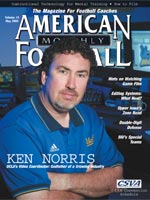AMERICAN FOOTBALL MONTHLY THE #1 RESOURCE FOR FOOTBALL COACHES
Article CategoriesAFM Magazine
|
What Next?Technology seems to be moving faster than the speed of lightby: Rex Lardner © More from this issue Jim Emery remembers many things during his career: a college football player at Ohio Wesleyan University, a graduate assistant, recruiting coordinator, college coach, mentor of many varied club football teams in Italy, and now, COO of Digital Scout, one of the software companies that helps football coaches at all levels prepare for their next opponent. “I coached in Italy for a good part of 18 years and saw a range of kids and adults competing in the sport,” said Emery. “The ages were from about 18 to 37. They were all shapes and sizes but one point bonded all of them: they had a passion for the game and knew that preparation and fundamentals were the essence of the game. It really is the same in both coaching and the business world. The bells a....The full article can only be seen by subscribers. Subscribe today!
|
|
|||||||
| HOME |
MAGAZINE |
SUBSCRIBE | ONLINE COLUMNISTS | COACHING VIDEOS |
Copyright 2026, AmericanFootballMonthly.com
All Rights Reserved





